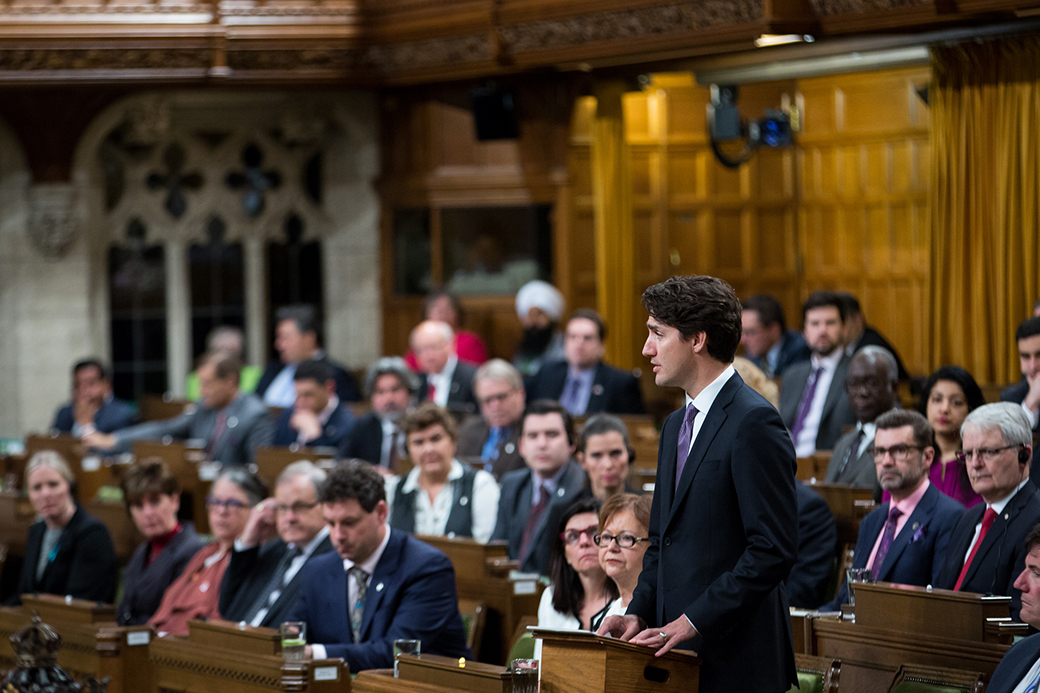“This parrot is no more. It has ceased to be. It’s expired and gone to meet its maker. This is a late parrot. It’s a stiff. Bereft of life, it rests in peace.” — John Cleese in a Monty Python’s Flying Circus TV skit
Electoral reform is deader than Monty Python’s fabled parrot — “it’s rung down the curtain and joined the choir invisible” as predicted in this column in late December.
But who killed the federal Liberals’ campaign promise, energetically repeated over 1,000 times, that 2015 “will be the last federal election conducted under the first-past-the-post voting system” as their website still says?
And what’s next to improve democracy?
The most obvious parrot and promise garroter is Prime Minister Justin Trudeau, who at least doesn’t deny strangling the electoral reform legislation he pledged to introduce “within 18 months of forming government.”
Last week’s announcement that he would not honour his campaign promise was breathtaking in its brutality.
And it was reminiscent of Pierre Trudeau’s style of making solemn pledges and then reversing completely — like opposing and ridiculing the wage and price controls proposed by the Conservatives in the 1974 federal election and then implementing them in 1975!
But Justin Trudeau had several unwitting accomplices in the crime — the federal New Democrats and Green Party and Fair Vote Canada, the advocacy group demanding electoral reform. They all inadvertently helped kill it.
How? By steadfastly refusing to demand a national referendum to let voters make the extremely important decision on what kind of electoral system Canada would use to choose those who govern.
Polling in May 2016 showed that 73 per cent per cent of voters wanted a referendum before any changes were made.
But the NDP, Greens and Fair Vote Canada were oblivious to voters’ concerns until it was too late.
Consider this Dennis Pilon article posted by Fair Vote Canada president Kelly Carmichael on their website in October.
“But holding a referendum on the voting system would be both undemocratic and, frankly, immoral. Undemocratic because just voting on something doesn’t mean the results are democratic if the process violates more important democratic principles,” wrote Pilon, a Fair Vote Canada national advisory board member. “Immoral because evidence from the recent provincial voting system referenda make clear that a referendum on this issue will fail to engage the public, and to promote something you know will fail as a process is to act in bad faith.”
Letting Canadians decide for themselves is “undemocratic and immoral?” Wow! That kind of contempt for voters played into the Liberals’ hands and gave them the opportunity to kill electoral reform altogether.
The NDP and Greens also opposed a referendum until it was clear they had no choice but to agree with Conservative Party demands for a vote if they hoped to have any chance of getting action from the Liberals.
The Greens’ faulty logic ran like this: “Do we need to have a referendum on electoral reform? No, because we already did.” The 2015 election was a referendum on reform, the party maintained.
But we didn’t have a referendum or anything close to it. The Liberals ran on a promise to get rid of our current first-past-the-post electoral system. But they did not propose any specific alternative so voters would know what they were getting.
And it’s simply self-serving rationalization to argue that the new Liberal government has an ironclad mandate for the more than 100 policies it proposed during the election campaign.
Sadly — I’m no Conservative — but only that party got the point that fundamental issues like changing electoral systems or the Constitution require a mandate directly from Canadians, not from a simple majority of 338 members of Parliament.
Yes, the Conservatives’ interests are served by the current system, just as the NDP and Greens were self-interested in mixed member proportional representation and the Liberals in preferential ballots. But all parties should have had enough confidence in their positions to seek voters’ support in a referendum.
“A referendum is the only way to ensure all Canadians get that say. It is arrogant for the government to suggest they are entitled to make a change of this magnitude without a referendum,” Conservative interim leader Rona Ambrose said in December — and she was right.
Those who were wrong were very, almost irrationally, wrong.
Pilon and Fair Vote Canada are certainly passionate and dedicated to their cause of changing electoral systems — but they have not had any success in several referenda.
Every referendum in Canada on changing electoral systems has failed, including the two in this province in 2005 and 2009, when I led NO BC STV, the group opposing the Single Transferable Vote that Fair Vote BC favoured. In the first referendum, 57.7 per cent of voters backed STV, below the 60 per cent threshold set by the Gordon Campbell government. Support fell to 39.1 per cent in the second referendum.
Ontario also rejected proportional representation in a 2007 referendum with 63 per cent against and Prince Edward Island voted it down with 63.5 per cent opposed in 2005.
P.E.I. tested support again last year with a multiple choice, non-binding plebiscite. Premier Wade MacLauchlan said the 36 per cent turnout, compared to a typical P.E.I. election turnout of 80 per cent, indicated a lack of interest.
“The combination of the voter turnout and the level of support means that just under one in five registered voters has supported mixed member proportional representation,” he noted.
The results on five different options were, ironically, tabulated using a preferential ballot where voters whose first choice ranked last then had their second choices counted. First past the post led from the first through third count, but in the final tally was topped by mixed member proportional representation by 52.4 per cent to 42.8 per cent.
The United Kingdom also shot down proportional representation in its 2011 referendum on electoral systems, with 68 per cent voting against changing the voting system.
While P.E.I.’s MacLauchlan took a common sense approach to electoral change, Pilon piled on the excuses for not having a referendum in his October Fair Vote Canada article.
“Research on the voting system referenda in B.C. and Ontario produced fairly consistent results: nearly half of the public voting in these three cases did not know a referendum was taking place and, amongst those who did, they reported very low knowledge about the issue,” he wrote. “Most who voted against change did so because they did not feel they could make an informed decision, clearly signaling a failed process.”
“Others made their decision on the basis of perceived party self-interest or cues from the party or ideological proxies (e.g. columnists), rather than a deliberation about the details and merits of the different systems,” the York University political science professor — who strongly advocated for the STV in BC — concluded.
Pilon does not mention that the pro-STV side outspent the NO STV forces by a significant margin in both votes, or that pro-STV material was sent by the BC Liberal government to every household before the 2005 ballot, or that the majority support in 2005 — below the required 60 per cent threshold — was more than reversed in 2009.
And after-the fact research doesn’t change the results decided by the more than 1.5 million British Columbians who actually voted.
But if electoral change is as dead as the proverbial parrot, what can be done to improve democracy while keeping our current system? Lots!
Start with mandatory voting, required in more than 30 countries, including Australia since 1927, where the average voter turnout is 93 per cent. Those who don’t vote are subject to a small fine equivalent to about $20.
Mandatory voting eliminates disgraceful party tactics like voter suppression, since it’s not possible when everyone has to cast a ballot, and forces politicians of all stripes to pay attention to communities and issues they would otherwise avoid.
Too radical? A slim majority of the relative few people who participated in the government’s MyDemocracy.ca online survey were opposed but Canada could try mandatory voting for one election and then evaluate the results.
Still don’t like mandatory? Then let’s give everyone who votes a $10 tax credit for participating. In the 2015 election there were 17.7 million voters for a 68 per cent turnout.
If we could increase that to 20 million voters — a 77 per cent turnout — the cost to the government would be $200 million, less than the cost of the last election at $375 million. While not cheap, that’s the price of a better, more inclusive democracy.
And charities could urge voters to take that $10 and give it to a good cause.
Then look at online voting — because it’s 2017! Surely we can at least do a pilot program to allow some voters to cast a ballot online. And 72 per cent of those who participated in the government’s survey, conducted online, agreed we should allow it.
When Canada’s six largest banks complete 614 million online financial transactions annually, surely we can find a way for 20 million votes to be secure every four years.
So let the dead parrot of electoral reform rest in peace and let’s get to work on practical changes to improve democracy without divisiveness. ![]()
Read more: Federal Politics
















Tyee Commenting Guidelines
Comments that violate guidelines risk being deleted, and violations may result in a temporary or permanent user ban. Maintain the spirit of good conversation to stay in the discussion.
*Please note The Tyee is not a forum for spreading misinformation about COVID-19, denying its existence or minimizing its risk to public health.
Do:
Do not: